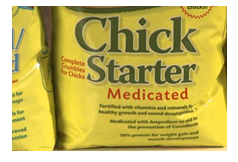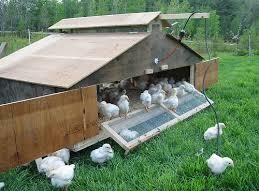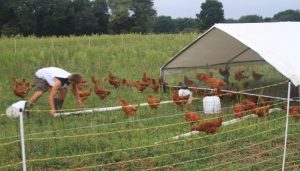
Feed suppliers, farm supply businesses, local hatcheries and mail order (online) hatcheries make good sources of strong, healthy baby chicks. Pooling your order with other project members can reduce your initial investment because discounts are usually given to larger orders. The few cents per chick charge for Mereck’s disease vaccination can provide great returns later on.
Mail order chicks will be shipped by US Postal Service during appropriate weather conditions. Chicks are usually sent out from the hatchery on Monday or Tuesday. With three-day guarantee delivery, you should receive them at your post office on Thursday or Friday.
They are mailed in a special box called a “Pullman.” Each compartment is designed for 25 chicks, so orders less than 25 will include mail chick of unspecified breeds, just to fill the space and provide proper heat in transit.
 Chicks can be artificially brooded like other poultry. However, since the goal is to raise the chicks on pasture, a “broody” hen that fosters them may get the chicks out on the range more quickly. This hen is sometimes called a “cluck hen” because of the clucking sound she makes. She is behaviorally and physiological changed by her natural hormones and instincts to incubate eggs and rear chicks.
Chicks can be artificially brooded like other poultry. However, since the goal is to raise the chicks on pasture, a “broody” hen that fosters them may get the chicks out on the range more quickly. This hen is sometimes called a “cluck hen” because of the clucking sound she makes. She is behaviorally and physiological changed by her natural hormones and instincts to incubate eggs and rear chicks.
A “broody” hen that is best for fostering chicks is one that has been setting on a nest of eggs for several days. Some breeds make better mothers than others. Loose feathered Cochins, Rocks, Wyandottes and many crossbreds are best, but individuals of other breeds may also be very satisfactory. A hen that is not “setting tight” may reject the chicks and even kill them.
The chicks should be introduced to the hen while she is in her nest box. Stay calm when sliding the chicken under the hen and keep her area darkened. It may even be necessary to cover her nest and restrain her in the box until she has accepted the chicks. Check the hen every little while to make sure that she has not rejected the chicks.
 A good hen may be able to brood as many as 20 chicks! A large hen is not necessarily a better mother than a small hen. Not only will a hen keep the chicks the proper temperature, she will direct them to water and feed. She will help the chicks to explore their environment and begin to forage for insects and vegetation. She will provide warmth for the chicks and call them under her cover when they need protection. A hen will reduce energy costs but feed consumption will increase since the hen will consume chick starter feed.
A good hen may be able to brood as many as 20 chicks! A large hen is not necessarily a better mother than a small hen. Not only will a hen keep the chicks the proper temperature, she will direct them to water and feed. She will help the chicks to explore their environment and begin to forage for insects and vegetation. She will provide warmth for the chicks and call them under her cover when they need protection. A hen will reduce energy costs but feed consumption will increase since the hen will consume chick starter feed.
A complete Chick Starter crumble insures that the babies receive a balanced ration in each bite. Whether the feed is medicated or non-medicated is the producer’s choice. The medication in starter feed is Amprolium is an amoebicide that prevents coccidiosis. The drug is a “thiamine analogue” and blocks the uptake of the vitamin thiamine by the infectious microbe. By killing the amoeba in the chicks gut, the disease is prevented.
Since the coccidiosis amoeba is found in soil and the intent is to get the chicks on pasture as soon as possible, this medication is recommended and allow under Label Rouge guidelines.
 The chicks can be introduced to the range as soon as the weather is suitable. They will need supplemental heat during the cool nights.
The chicks can be introduced to the range as soon as the weather is suitable. They will need supplemental heat during the cool nights.
Fresh pasture can be provided by moving the birds to new areas frequently. Native grass pasture is commonly used because of its durability and recovery after the birds graze it off. Legumes such as alfalfa and clover pasture will increase protein consumption. This will allow the supplemental ration to be higher in whole and cracked grains.
Electrified temporary fences will prevent the devastating on predators such as fox, raccoon and opossum.
 If rapture predators like hawks, owls and eagles are a concern, roof netting may need to be applied. For a small number of birds, a chicken tractor will provide protection from above, but requires more labor and expense.
If rapture predators like hawks, owls and eagles are a concern, roof netting may need to be applied. For a small number of birds, a chicken tractor will provide protection from above, but requires more labor and expense.


















